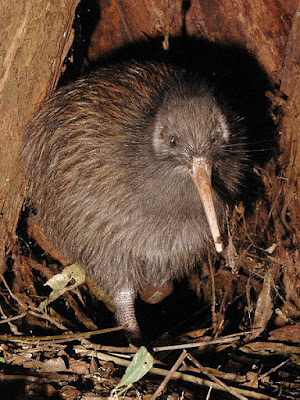Some Birds Won't Fly
The average New Zealander is about the size of a domestic chicken. Their nostrils are at the end of their long beaks, many are endangered, and they are strongly territorial —
"That's wrong on so many levels, Cowboy Bob!"
I was doing humor based on conflation. In this case, the kiwi bird is the national symbol of New Zealand, and the people are internationally known as Kiwis. (They are also known for having a great sense of humour, a fact of which I am certain because I just made it up.) If evolutionists can use conflation (such as using variations in organisms to imply that bacteria-to-bird evolution is true), and make up their own "facts", is it necessarily wrong for other people to do the same? But I've dealt with that many times before, so don't pay it no nevermind just now. Anyway, the kiwi ties in with the rest of this post about flightless birds.
Although they have no scientific backing it, evolutionists believe that flightless birds evolved from a common ancestor that once flew, and these varieties lost their abilities. Naturally, biblical creationists reject the long-age naturalistic evolutionary view, but are divided: did God create some to be flightless, or did they lose their flying abilities? There are points to be made both ways, but some non-flying birds are exceptionally well suited for their environments, such as the penguin.
Are flightless birds the product of a common ancestor that flew, and then they lost their ability to fly later on? Creationists have different views on this, as well as rejecting long-age evolutionary assumptions.
"That's wrong on so many levels, Cowboy Bob!"
I was doing humor based on conflation. In this case, the kiwi bird is the national symbol of New Zealand, and the people are internationally known as Kiwis. (They are also known for having a great sense of humour, a fact of which I am certain because I just made it up.) If evolutionists can use conflation (such as using variations in organisms to imply that bacteria-to-bird evolution is true), and make up their own "facts", is it necessarily wrong for other people to do the same? But I've dealt with that many times before, so don't pay it no nevermind just now. Anyway, the kiwi ties in with the rest of this post about flightless birds.
 |
| Kiwi image credit: Wikimedia Commons / Maungatautari Ecological Island Trust |
How would you describe a bird? Why, it is a feathered creature that flies through the air, of course! Flight is perhaps the most distinctive and enviable characteristic of birds. Genesis 1:20 even tells us that on Day Five of the Creation Week, God spoke into existence “fowl that may fly above the earth.”To read the rest, click on "Flightless Birds—Alternate Flight Plan".
But wait! There are 38 species and endemic island subspecies of flightless land birds and 26 flightless waterbirds alive today (out of approximately 10,000 present-day bird species). They can be placed in four major categories: the ratites, penguins, rails, and waterbirds (and additionally two unusual species—a parrot called the kakapo and the heron-like kagu of New Caledonia).
Did God originally design them this way, or did they lose their ability to fly? How can they be explained as part of God’s creation? Let’s take a look at each category to see any evidence of special design, and then you decide.
Are flightless birds the product of a common ancestor that flew, and then they lost their ability to fly later on? Creationists have different views on this, as well as rejecting long-age evolutionary assumptions.